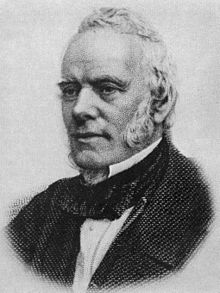George Fife Angas
George Fife Angas (born May 1, 1789 in Newcastle upon Tyne , Great Britain , † May 15, 1879 in Angaston , South Australia , Australia ) was a businessman, parliamentarian, philanthropist and is also known as one of the founders of South Australia.
Early life
George Angas was the seventh son of Caleb Angas , a wheelwright , and Sarah Angas , nee Lindsay Caleb. George Angas grew up in a religious family that determined his life. After the death of his mother, he attended boarding school and, at the age of 15, became an apprentice to his father. He later went to London and came back to Newcastle in 1809 in his father's business, where he successfully devoted himself to business and social issues.
He married Rosetta French (1793-1867) in April 1812, with whom he had three sons and daughters.
Career advancement
Angas worked for his father's company for 20 years after his stay in London.
He then got involved in building the British colony of South Australia and was involved in the South Australian Company , which was to sell land on behalf of the British Crown. The success of the colonization of South Australia depended on the work of institutions such as the Colonial Office , the Board of Commissioners and the South Australian Company ; however, there were differences of opinion between the board and the company about the selling price of land. As a result, the South Australian Banking Company was founded in 1837 at the instigation of Angas to carry out this task. On behalf of the Bank of England , he trained staff, wrote information, kept in touch with the press and was involved in the founding of the Union Bank of Australia in 1836, as well as the Provincial National Bank in 1833 and South Australian Banking Co in 1840. He was also involved in the colonization of New Zealand .
In 1836 Angas met with Pastor August Kavel from Klemzig in the then Prussian province of Brandenburg and discussed with him the immigration of citizens who were followers of the Old Lutheran faith and therefore reprisals from the Prussian King Friedrich Wilhelm III. who wanted to unite the Lutheran and Reformed Churches to form the Church of the Old Prussian Union . People in the Klemzig area wanted to stay in the Old Lutheran Church. In 1838 Angas chartered four ships for the emigrants, the Prince George , Bengalee , Zebra and Catharina . The emigrants of the four ships founded three places in their new home: the passengers of the Bengalee and Prince George the place Klemzig , the passengers of the zebra the place Hahndorf and those of the Catharina the place Glen Osmond .
This shipping operation cost Angas £ 8,000 as the government refused to cover the transport costs and the recession of the 1840s caused him financial problems. So he had to sell his shares in Union Bank and other companies. The colony was also in economic trouble and the Colonial Office deposed the first Governor of South Australia, George Gawler , because the colony was threatened with insolvency. Also in 1842 Angas was intensely committed to South Australia and wrote Facts Illustrative of South Australia , information that was widely circulated at the time. Angas wanted to solve his financial problems by selling land in the north of England, but he did not succeed until 1850, but the German settlers were able to repay some of the borrowed money to him. There are also views that his support for the German emigrants ran into financial problems. Due to the prolonged exposure, he fell ill and decided to emigrate to Australia in 1851.
Late life
Angas was elected to the parliament of South Australia in the electoral district of Barossa Valley in the 1850s, traded merino sheep and cattle, and employed immigrants on his land in Australia. He worked in Parliament until 1867 and campaigned for the Northern Territory to be founded, contrary to the prevailing politics in South Australia, and devoted himself to building schools, churches and community facilities. In 1869 he published the history of the Newcastle-on-Tyne Sunday School Union , looked after his Angaston estate, and died in 1879 at the age of 90.
Honors
In Adelaide , in the Angas Gardens , a large stone cenotaph with a bronze plaque from Angas is located. The small Australian town of Angaston and Angas Street in downtown Adelaide are named after him.
Web links
- "The Confessional Lutheran Emigrations From Prussia And Saxony Around 1839" , Westerhaus, Martin O.
- Family album , 1836-1886 (MS4296).
Individual evidence
- ↑ a b nla.gov.au Family album , 1836–1886, in English, accessed on August 19, 2011
- ^ A b gutenberg.net.au : Angas, George Fife (1789–1879), in English, accessed on August 19, 2011
- ↑ adb.online.edu.au : Angas, George Fife (1789 - 1879) , in English, accessed on August 19, 2011
- ↑ pioneerssa.org.au ( Memento of the original from June 17, 2005 in the Internet Archive ) Info: The archive link was inserted automatically and has not yet been checked. Please check the original and archive link according to the instructions and then remove this notice. : The Pioneers Association of South Australia Inc, accessed August 18, 2011
- ↑ panedia.com : Angas Gardens with a picture of the memorial, accessed on September 12, 2011
- ↑ southaustralianhistory.com : Angaston, in English, accessed September 12, 2011
| personal data | |
|---|---|
| SURNAME | Angas, George Fife |
| BRIEF DESCRIPTION | Australian politician |
| DATE OF BIRTH | May 1, 1789 |
| PLACE OF BIRTH | Newcastle upon Tyne , UK |
| DATE OF DEATH | May 15, 1879 |
| Place of death | Angaston , South Australia , Australia |

